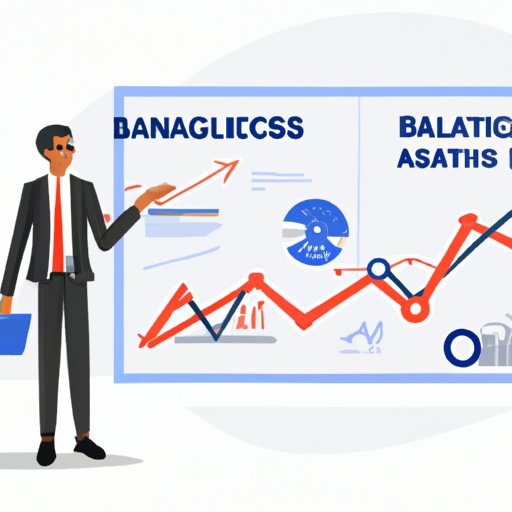I. Introduction
Business analytics is a powerful tool for decision making, providing insights that inform critical strategic and operational decisions. Business analytics involves the collection, management, analysis, and interpretation of data needed to make informed business decisions.
In today’s fast-paced, highly competitive business landscape, companies can no longer rely on intuition or guesswork when making decisions. To remain competitive, businesses must make data-driven decisions, based on hard facts and insights gained through analytics.
II. The Power of Data-Driven Decision Making: The Role of Business Analytics in Today’s Business Landscape
Data-driven decision making involves the use of data and analytics to inform and guide business decisions. By using data and analytics, businesses can make more informed decisions that are backed by information, rather than intuition or personal biases. Business analytics plays an essential role in data-driven decision making by providing the insights necessary to make informed decisions.
Data-driven decision making can result in significant benefits for businesses, including improved efficiency, increased revenue, reduced costs, improved customer satisfaction, and more. Many successful companies, such as Amazon, Google, and Netflix, are known for their data-driven decision-making approach, which has contributed to their success.
III. Why Businesses Can’t Afford to Ignore Analytics When Making Critical Decisions
Critical decisions can have a significant impact on a business, with potential consequences ranging from increased revenue and growth to the loss of customers, revenue, and market share. Making decisions based on feelings or assumptions can lead to poor outcomes, missing valuable opportunities, and exposure to unnecessary risks.
The role of business analytics in decision making is to reduce risks and improve the accuracy of decisions. By analyzing data, businesses can gain insights that help identify opportunities and potential challenges, ultimately leading to better decisions.
Ignoring analytics can result in significant negative consequences. For example, Kodak’s failure to adopt digital photography and Blockbuster’s failure to embrace online streaming ultimately led to their decline.
IV. From Insights to Action: How Business Analytics Paves the Way for Smart Decision Making
Business analytics involves the process of collecting data, analyzing it, and turning it into insights that inform business decision making. However, insights alone are not enough. It is crucial to turn these insights into actions.
Business analytics helps organizations identify new business opportunities and make informed decisions. For example, by analyzing customer data, businesses can identify trends and patterns that help them to improve their customer experience or develop new products and services that meet the needs of their customers.
V. Navigating the Complexity of Business Decisions with Analytics: A Primer for Decision Makers
Business decisions can be complex, involving multiple variables, competing priorities, and limited resources. Business analytics can help simplify these complex decisions by providing data-driven insights and predictions.
There are many analytics tools and techniques available, from basic descriptive analytics to advanced predictive and prescriptive analytics. By choosing the right tools and techniques, businesses can gain valuable insights and improve the accuracy of their decisions.
Best practices for using analytics in decision making include defining clear objectives, using reliable data sources, selecting the appropriate tools and techniques, and validating findings with subject matter experts.
VI. The Benefits of Leveraging Business Analytics in Real-time Decision Making
Real-time decision making is becoming increasingly important in today’s fast-paced business environment, where decisions must be made quickly to remain competitive. Business analytics plays a critical role in supporting real-time decision-making efforts.
Real-time analytics involves the use of data in real-time to make informed decisions. By using real-time data, businesses can identify trends and patterns quickly, and respond more quickly to changing market conditions or emerging opportunities.
Real-time analytics can improve decision making across all areas of the organization, including marketing, sales, operations, and finance. Companies such as Twitter and Facebook use real-time analytics to gain insights into user behavior, trends, and preferences, allowing them to quickly adapt to changing conditions.
VII. Maximizing Competitive Advantage Through Analytics-Enabled Decision Making
Analytics can provide a significant competitive advantage for businesses. By using analytics to gain insights into customer behavior, preferences, and needs, businesses can develop products and services that better meet customer needs, target their marketing efforts more effectively, and optimize their operations to reduce costs and improve efficiency.
Many successful companies, such as Amazon, use analytics to gain a competitive advantage. Amazon’s recommendation engine, powered by analytics, is one of the reasons behind the company’s success.
Best practices for using analytics to gain a competitive advantage include developing a clear strategy, defining clear objectives, selecting the right data sources and tools, analyzing data regularly, and validating findings with subject matter experts.
VIII. Capitalizing on the Insights: How Business Analytics Supports Effective Decision Making Across All Functional Areas
Business analytics can support effective decision making across all functional areas of the organization, including finance, marketing, operations, and human resources. By leveraging analytics, businesses can gain insights into customer behavior, operational performance, financial performance, and more.
To integrate analytics into decision-making processes across all functional areas, businesses must define clear objectives for each area, select the right data sources and tools, and ensure the findings are validated with subject matter experts.
Challenges in using analytics to support decision making across all functional areas include data quality, integration challenges, and limited resources.
IX. Conclusion
Business analytics is a critical tool for decision making, providing organizations with the insights needed to make informed decisions. Analytics can help reduce risks, improve efficiency, increase revenue, and gain a competitive advantage.
By understanding the importance of data-driven decision making, leveraging real-time analytics, capitalizing on insights, and using best practices, businesses can gain a competitive advantage and achieve their desired outcomes.
It is time to take action and implement analytics in decision-making processes across all areas of the organization.
(Note: Is this article not meeting your expectations? Do you have knowledge or insights to share? Unlock new opportunities and expand your reach by joining our authors team. Click Registration to join us and share your expertise with our readers.)
